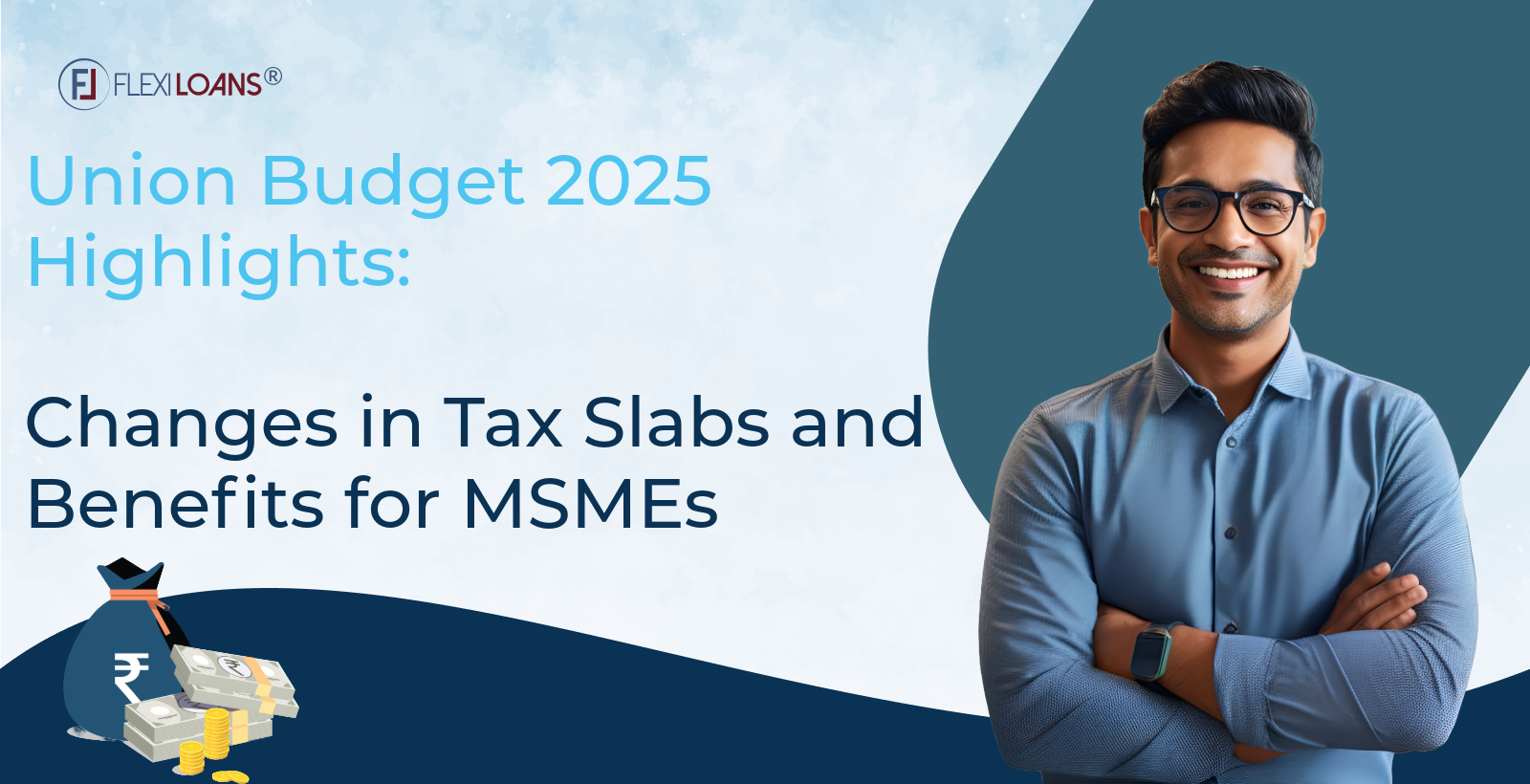Feb 27, 2025
Jun 25, 2025

The Union Budget 2025 has introduced significant reforms to boost economic growth, ease taxation, and strengthen the MSME sector. As businesses navigate financial challenges, the government has unveiled policies to enhance credit access, simplify tax structures, and support small enterprises.
There will be no income tax payable up to ₹12 lakh, providing substantial relief to middle-class taxpayers.
This year’s budget focuses on streamlining income tax, providing targeted relief to MSMEs, and refining GST regulations. For entrepreneurs and salaried individuals, understanding these reforms is crucial for strategic financial planning.
In this blog, we break down tax slab changes, MSME benefits, GST updates, and new government schemes. Read on to explore how these measures can impact your business and finances.
Key Highlights of Union Budget 2025
The Union Budget 2025 has introduced a range of reforms to drive economic growth, ease financial burdens on taxpayers, and empower Micro, Small, and Medium Enterprises (MSMEs). The government has focused on simplifying taxation, increasing credit accessibility, enhancing digital transformation, and strengthening financial support for businesses.
Here’s a detailed breakdown of the major takeaways from the budget:
1. Revised Income Tax Slabs – Enhanced Relief for Middle-Class Taxpayers
The budget introduces new tax slabs aimed at reducing the financial burden on middle-income groups and encouraging savings. The revised structure lowers tax rates for individuals earning between ₹5 lakh and ₹15 lakh, providing more disposable income.
Key Changes:
- Lower tax rates for middle-income groups, reducing overall tax liability.
- Standard deduction increased for salaried employees.
- Higher exemption limits for senior citizens to provide better financial security.
Impact:
- Higher savings and spending power for the middle class.
- Encouragement for entrepreneurship, as small business owners benefit from tax relief.
- Boost to consumer demand, supporting industries reliant on domestic spending.
This tax relief is expected to increase investments in MSMEs, as individuals may use their additional savings to fund new ventures.
2. MSME Loan Schemes – Easier Credit Access Through Digital Platforms Like FlexiLoans
Recognising the vital role of MSMEs in economic growth, the government has expanded loan schemes to improve access to working capital. Digital lending platforms like FlexiLoans play a crucial role in simplifying loan approvals, reducing paperwork, and ensuring faster disbursals.
Key Announcements:
- Collateral-free loan limits increased, making credit accessible to more small businesses.
- Interest subsidies introduced for loans granted to MSMEs adopting green and digital technologies.
- Expansion of digital lending platforms, ensuring faster loan approvals.
Impact on MSMEs:
- Reduced dependency on traditional banks, thanks to fintech-driven lending platforms.
- Easier working capital access, allowing small businesses to invest in growth and expansion.
- Faster loan processing, enabling entrepreneurs to seize business opportunities without financial delays.
FlexiLoans simplifies this process by offering quick MSME loans, customised repayment plans, and hassle-free digital applications.
3. GST Simplification – Reduced Compliance Burden for Small Businesses
The budget introduces several reforms aimed at simplifying GST compliance, reducing tax complexities, and minimising operational hurdles for MSMEs.
Key Changes:
- Quarterly GST filing for businesses with an annual turnover below ₹5 crore.
- Lower GST rates on essential goods and services, benefiting small retailers and manufacturers.
- Automated invoicing and compliance tracking to reduce manual paperwork.
Impact on Small Businesses:
- Less time spent on compliance, allowing businesses to focus on expansion.
- Lower tax rates, making products and services more affordable for consumers.
- Transparency in transactions, ensuring seamless tax filings.
With these changes, businesses can now focus on operations instead of tax complexities, boosting overall efficiency.
4. Startup Incentives – Tax Exemptions Extended for Early-Stage Ventures
To encourage entrepreneurship, the government has extended tax exemptions for startups and introduced additional benefits for investors.
Key Announcements:
- Tax holiday extended for startups up to 5 years from incorporation.
- Exemption on capital gains tax for angel investors and venture capitalists.
- Simplified regulatory approvals, reducing bureaucratic delays for new businesses.
Impact:
- Encouragement for new startups, fostering innovation and job creation.
- Increased investor confidence, as tax breaks make startup investments more attractive.
- Lower financial risk for entrepreneurs, allowing them to focus on scaling operations.
With easier access to Business Loan through FlexiLoans, startups can fund their operations efficiently without the burden of heavy tax liabilities.
5. Subsidies & Financial Support – Increased Allocations for MSME Growth
The government has increased financial support for small businesses and rural entrepreneurs, ensuring their sustainability and competitiveness.
Key Announcements:
- Higher subsidies for MSMEs investing in green technologies and automation.
- Expansion of the Credit Guarantee Fund, providing risk-free loans to small businesses.
- Special financial assistance for women entrepreneurs and rural startups.
Impact:
- Cost reduction for MSMEs, enabling better profit margins.
- Encouragement for tech-driven businesses, promoting digital transformation.
- Higher credit availability, reducing financial stress on small business owners.
By leveraging digital lending platforms like FlexiLoans, MSMEs can access these funds efficiently and invest in long-term growth.
6. Ease of Doing Business – Digitalisation & Automation Initiatives to Streamline Operations
The government has intensified efforts to simplify business operations through technology-driven policies.
Key Announcements:
- Fully digitalised company registration and compliance processes.
- Introduction of AI-powered tax filing assistance for businesses.
- Automation of government approvals, reducing bureaucratic delays.
Impact:
- Faster business setup, cutting down registration timelines.
- Lower operational costs, as digital tools replace manual processes.
- Enhanced transparency, reducing corruption and inefficiencies.
With seamless digital loan applications available through FlexiLoans, small businesses can navigate financial challenges easily while benefiting from digital government initiatives.
Let’s explore these updates in detail.
Changes in Tax Slabs for FY 2025-26
The Union Budget 2025 has introduced a revised income tax structure aimed at reducing the financial burden on taxpayers. The updated tax slabs provide relief to middle-income earners while ensuring higher contributions from those in higher income brackets. Below is the new tax structure for FY 2025-26:
Comparison of Income Tax Slabs
| Income Range (₹) | Tax Rate (FY2024-25) | Tax Rate (FY 2025-26) |
|---|---|---|
| Up to 3,00,000 | Nil | – |
| Up to 4,00,000 | – | Nil |
| 3,00,001 to 6,00,000 | 5% | – |
| 4,00,001 to 8,00,000 | – | 5% |
| 6,00,001 to 9,00,000 | 10% | – |
| 8,00,001 to 12,00,000 | – | 10% |
| 9,00,001 to 12,00,000 | 15% | – |
| 12,00,001 to 15,00,000 | 20% | – |
| 12,00,001 to 16,00,000 | – | 15% |
| 16,00,001 to 20,00,000 | – | 20% |
| 15,00,001 and above | 25% | – |
| 20,00,001 to 24,00,000 | – | 25% |
| Above 24,00,000 | – | 30% |
Note: These changes are applicable under the new tax regime for FY 2025-26 (AY 2026-27).
Key Changes:
- Increased Basic Exemption Limit: The basic exemption limit has been raised from ₹3,00,000 to ₹4,00,000, providing relief to low-income taxpayers.
- Adjusted Income Brackets: Each subsequent income bracket has been expanded by ₹1,00,000, offering reduced tax rates for middle-income groups.
- Higher Tax Rate for Top Bracket: A new tax rate of 30% has been introduced for income above ₹24,00,000, ensuring higher contributions from high-income earners.
These revisions aim to simplify the tax structure and promote equitable taxation across different income levels.
Impact of Tax Slab Changes
- Lower Tax Liability for Middle-Income Earners
- Individuals earning up to ₹8 lakh will now be taxed at a maximum of 5%, providing significant relief.
- Those earning up to ₹12 lakh will pay a reduced tax rate of 10%, making it easier to manage disposable income.
- Higher Tax Rates for High-Income Groups
- Income above ₹20 lakh now falls under the 25% and 30% brackets, ensuring greater contributions from high earners.
- The government aims to generate additional revenue while maintaining fairness in taxation.
- Business Owners and MSMEs
- Small business owners who report income under these slabs will benefit from structured tax savings.
- MSMEs should explore tax-saving investments and deductions to optimise their financial planning.
These tax revisions encourage compliance while ensuring a balanced approach to economic growth. To further reduce tax liabilities, MSMEs can leverage government-backed loan schemes and fintech solutions such as FlexiLoans to optimise cash flow and reinvest in their businesses.
MSME Benefits & Schemes Announced
The MSME sector remains a priority, with several incentives aimed at growth and financial stability:
1. MSME Loan Schemes 2025
- Collateral-free loans available through fintech platforms like FlexiLoans.
- Interest rate reductions for businesses adopting eco-friendly practices.
- Faster disbursal processes via digital lending solutions.
2. Reduced Compliance Burdens
- Simplified tax filing procedures.
- One-time settlement schemes for old tax disputes.
3. Industry-Specific Benefits
- Manufacturing MSMEs get subsidies for adopting automation.
- Service-sector businesses benefit from easier credit access.
These measures aim to improve liquidity and ease business operations for small enterprises. FlexiLoans provides customised loan solutions that align with these policy changes, helping MSMEs scale efficiently.
GST and Indirect Tax Updates
The government has introduced several modifications to the GST framework, including:
- Reduced GST on essential goods – Beneficial for retail and manufacturing MSMEs.
- Quarterly GST filing for businesses with turnover below ₹5 crore.
- Automated compliance systems to minimise paperwork.
- Customs duty revisions on imported raw materials to lower production costs.
These reforms will ease financial strain and encourage small businesses to expand operations.
Government Schemes & Financial Support for MSMEs
1. Enhanced Credit Guarantee Schemes
The government has expanded the Credit Guarantee Fund Scheme for MSMEs (CGTMSE), ensuring easy access to collateral-free loans. Platforms like FlexiLoans simplify this process, offering seamless application and quick approval.
2. Digital Transformation Support
- Grants for AI adoption in business processes.
- Subsidies for cloud-based financial management tools.
3. Direct Financial Assistance
- Export subsidies for MSMEs focusing on global markets.
- Working capital support for businesses affected by economic downturns.
These initiatives strengthen financial stability while encouraging business loan adoption for growth.
Industry Reactions & Expert Opinions
Finance Experts’ Take
Industry professionals view these measures as a positive step towards financial inclusion. According to market analysts, tax reductions will enhance cash flow, while easy MSME financing will promote entrepreneurship.
MSME Associations’ Response
Leading MSME organisations have welcomed the government’s focus on digital lending. The expansion of platforms like FlexiLoans ensures better credit accessibility, fostering sector-wide growth.
Comparison with Previous Budgets
- Higher allocations for MSME development.
- Improved tax exemptions for new businesses.
- Greater push for digital transactions and fintech partnerships.
How MSMEs Can Leverage These Benefits
The Union Budget 2025 introduces several incentives designed to ease financial pressures and encourage business growth. MSMEs should strategically use these benefits to improve profitability, expand operations, and ensure long-term sustainability. Here’s how businesses can maximise these opportunities.
1. Utilise Tax Exemptions by Investing in Eligible Business Assets
The government has introduced tax exemptions and relief measures to reduce the financial burden on MSMEs. Businesses can take advantage of these incentives by making strategic investments in assets that qualify for tax deductions.
Key Strategies to Optimise Tax Savings
- Invest in Equipment and Machinery – Upgrading machinery or purchasing new tools can help businesses claim depreciation benefits, lowering taxable income.
- Hire More Employees – Under Section 80JJAA, businesses hiring additional workers can claim tax deductions on salaries paid to new employees.
- Upgrade to Energy-Efficient Solutions – Investing in solar energy, sustainable manufacturing, or energy-efficient equipment can qualify businesses for tax rebates.
- Claim Input Tax Credit (ITC) on GST – Proper record-keeping enables businesses to offset GST paid on raw materials and services, reducing overall tax liability.
Taking advantage of these exemptions can improve cash flow and allow businesses to reinvest savings into expansion.
2. Apply for MSME Loan Schemes via Digital Lending Platforms Like FlexiLoans
Access to credit remains a key challenge for MSMEs. The budget enhances financial support through government-backed loan programs, making it easier for small businesses to secure funding.
Why Digital Lending is a Game-Changer
- Faster Loan Approvals – Digital lenders like FlexiLoans offer quick approvals through AI-driven assessments, reducing wait times.
- Minimal Documentation – MSMEs can access funds with basic KYC details and financial statements, simplifying the application process.
- Flexible Repayment Terms – Custom repayment plans allow businesses to manage finances more effectively.
- Collateral-Free Loans – Many government-backed schemes, such as the Credit Guarantee Fund Scheme for MSMEs (CGTMSE), provide funding without requiring collateral.
MSMEs can utilise these financing options to expand operations, manage working capital, and invest in business growth.
3. Adopt Fintech Solutions to Streamline Financial Management
The government is pushing for digital transformation in the MSME sector, encouraging businesses to integrate fintech solutions for better financial management.
How Fintech Can Help MSMEs
- Automated Accounting Software – Cloud-based platforms help businesses manage revenue, track expenses, and file taxes efficiently.
- AI-Powered Expense Management – Advanced analytics help MSMEs optimise spending and plan budgets.
- Online Payment Solutions – Digital transactions via UPI, net banking, and wallets improve cash flow and customer convenience.
- Real-Time Business Analytics – AI-driven tools provide insights into financial health, helping businesses make data-driven decisions.
Adopting fintech solutions can reduce manual errors, improve efficiency, and ensure compliance with tax regulations.
4. Take Advantage of Government Grants for Digital Transformation
To enhance competitiveness, the government has introduced grants and subsidies for MSMEs investing in digital transformation and technology adoption.
Available Digitalisation Incentives
- Subsidies for ERP and CRM Implementation – Businesses investing in Enterprise Resource Planning (ERP) or Customer Relationship Management (CRM) software can receive financial assistance.
- Technology Upgradation Grants – MSMEs adopting cloud computing, artificial intelligence, and automation tools can access funding support.
- E-commerce Promotion Schemes – Businesses expanding into digital marketplaces can receive incentives to establish online stores.
- Startup and Innovation Grants – New MSMEs working on innovative technology solutions can apply for special grants and incubation support.
By modernising operations and integrating digital tools, businesses can improve productivity, reduce costs, and enhance customer experiences.
Conclusion
The Union Budget 2025 introduces crucial reforms aimed at strengthening the MSME sector and easing tax burdens. Lower income tax rates, expanded MSME loan schemes, simplified GST compliance, and government-backed financial support create a favourable business environment. These measures provide small enterprises with the tools needed to enhance profitability, streamline operations, and expand sustainably.
By leveraging tax exemptions, securing financing through digital lending platforms like FlexiLoans, adopting fintech solutions, and utilising government grants, MSMEs can position themselves for long-term success. Strategic financial planning and digital transformation will be key to maximising these benefits.
Staying informed and taking proactive steps will help businesses remain competitive in an evolving economic landscape. MSMEs should explore the available incentives and take advantage of tailored financial solutions to drive growth. Share your thoughts on how this budget impacts your business in the comments below. Let’s build a stronger MSME ecosystem together.
Staying updated on policy changes is essential. MSMEs should explore platforms like FlexiLoans, which align with government initiatives to facilitate seamless business financing.
FAQs
The updated tax brackets reduce rates for middle-income groups, ensuring higher savings and financial flexibility.
With easier loan access, reduced tax burdens, and sector-specific incentives, MSMEs benefit from improved financial health.
Yes, the government has launched new credit guarantee programs to facilitate MSME growth through fintech lenders like FlexiLoans.
Revised rates for essential goods, simplified filing for small businesses, and automation-driven compliance systems.
Tax exemptions, startup loan schemes, and ease of compliance make it a favorable landscape for emerging businesses.







